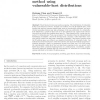122 search results - page 5 / 25 » Modeling the Spread of Active Worms |
MMMACNS
2005
Springer
14 years 29 days ago
2005
Springer
Abstract. The recent proliferation of Internet worms has raised questions about defensive measures. To date most techniques proposed are passive, in-so-far as they attempt to block...
PADS
2005
ACM
14 years 1 months ago
2005
ACM
Most well-known Internet worms, such as Code Red, Slammer, and Blaster, infected vulnerable computers by scanning the entire Internet IPv4 space. In this paper, we present a new s...
IPCCC
2007
IEEE
14 years 1 months ago
2007
IEEE
— Localized scanning is a simple technique used by attackers to search for vulnerable hosts. Localized scanning trades off between the local and the global search of vulnerable h...
IJSN
2007
13 years 7 months ago
2007
: Most Internet worms use random scanning. The distribution of vulnerable hosts on the Internet, however, is highly non-uniform over the IP-address space. This implies that random ...
INFOCOM
2003
IEEE
14 years 22 days ago
2003
IEEE
— It has been clear since 1988 that self-propagating code can quickly spread across a network by exploiting homogeneous security vulnerabilities. However, the last few years have...

